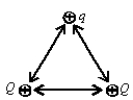Multiple Choice
Two particles, each with charge Q, and a third particle, with a charge q, are placed at the vertices of an equilateral triangle as shown. The total force on the particle with charge q is: 
A) Parrallel to the left side of the triangle
B) Parrallel to the right side of the triangle
C) Parrallel to the bottom side of the triangle
D) perpendicular to the bottom side of the triangle
E) perpendicular to the left side of the triangle
Correct Answer:

Verified
Correct Answer:
Verified
Q2: Charge is distributed uniformly on the surface
Q10: A particle with charge Q is on
Q13: Consider the following procedural steps: <img src="https://d2lvgg3v3hfg70.cloudfront.net/TB3976/.jpg"
Q17: Two uncharged metal spheres, L and M,
Q23: To make an uncharged object have a
Q30: Two small charged objects repel each other
Q34: A positively charged insulating rod is brought
Q37: Two particles A and B have identical
Q40: A charged insulator can be discharged by
Q41: A neutral metal ball is suspended by